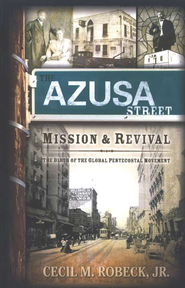Mel Robeck: The Azusa Street Mission and Revival
 Cecil M. Robeck, Jr., The Azusa Street Mission And Revival: The Birth Of The Global Pentecostal Movement (Nashville: Thomas Nelson Publishers, 2006), 342 pages.
Cecil M. Robeck, Jr., The Azusa Street Mission And Revival: The Birth Of The Global Pentecostal Movement (Nashville: Thomas Nelson Publishers, 2006), 342 pages.
About ten years ago, I audited a seminary course about the Pentecostal Movement. The course was a cooperative effort between Gordon-Conwell Theological Seminary and Harvard Divinity School. The classes were held at Harvard Divinity School and were team-taught by two professors, one from each of the respective schools. During that course, the Harvard professor, Harvey Cox, said that if Cecil Robeck ever sat down to write about Azusa Street that his book would be the definitive work on the subject. If that is true, we have the first volume now available (Robeck indicates in the book that he expects more volumes to follow). The release of this book is very timely; it coincides with the one hundredth anniversary of the outpouring of the Holy Spirit at the Azusa Street Mission.
Robeck has done extensive research for this book. The book is filled with detailed information about dates, times, places and people. He has gathered this information from a number of sources including interviews with eyewitnesses of the revival and the secular press. The variety of his sources allows him to show the reader how Azusa Street was viewed by both believers and unbelievers alike. Writing about one hundred years after the revival allows Robeck to step back and be fairly objective in interpreting the facts that he has gathered.
The book gives considerable attention to the pastor of the Azusa Street Mission, William J. Seymour. Robeck looks at various factors that contributed to making Seymour the leader that he was, namely his upbringing and spiritual journey. Seymour comes across as a very humble and devout man, who was a team player. One indication of this was that he had a leadership team at the mission that was made up of both men and women and was multi-ethnic. Another evidence of his team spirit was his desire to cooperate, and work with leaders of other Pentecostal ministries. Though Seymour was humble he was also very strong, he had to deal with difficult issues at the mission as well as multiple attempts by leaders, from outside of the mission, who tried to discredit him or steal his ministry.
The book also gives one a good look at the services of the Azusa Street mission. Robeck writes about various aspects of the services including, the worship, preaching and singing that took place at the mission. One very interesting section dealt with singing in the Spirit. The revival had many critics, from both inside and outside the church, but one thing that seems to have especially touched the visitors at Azusa Street was hearing the congregation sing in tongues. When writing about the mission Robeck does not attempt to gloss over, or cover up the shortcomings of the mission, questionable practices and false doctrines are mentioned along with the revival’s positive aspects.
Category: Church History, Fall 2006


